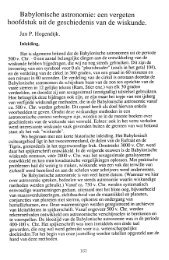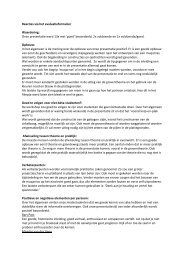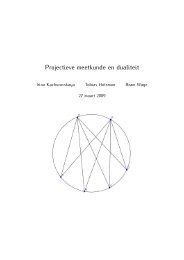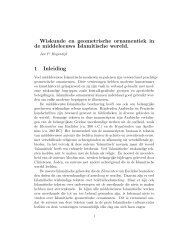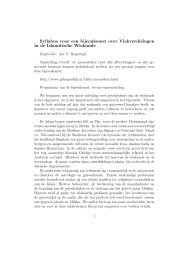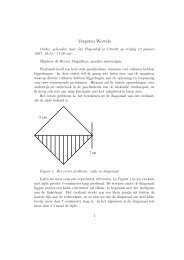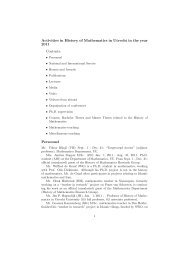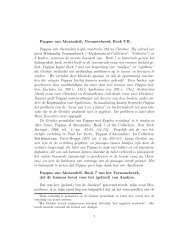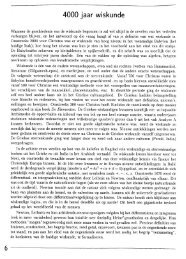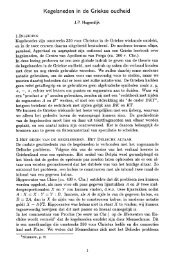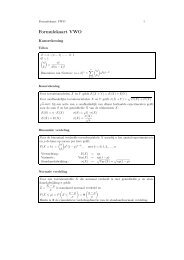Desargues' Brouillon Project and the Conics of ... - J.P. Hogendijk
Desargues' Brouillon Project and the Conics of ... - J.P. Hogendijk
Desargues' Brouillon Project and the Conics of ... - J.P. Hogendijk
You also want an ePaper? Increase the reach of your titles
YUMPU automatically turns print PDFs into web optimized ePapers that Google loves.
28 Jan I! <strong>Hogendijk</strong><br />
not state that <strong>the</strong> Apollonian latus rectum is perpendicular to LM,<br />
<strong>and</strong> he does not discuss <strong>the</strong> case <strong>of</strong> <strong>the</strong> parabola.<br />
One may well ask why Desargues did not mention <strong>the</strong> <strong>Conics</strong> or<br />
Apollonius explicity in <strong>the</strong>se five quotations. Perhaps he was afraid<br />
to criticize <strong>the</strong> work <strong>of</strong> a geometer who was so admired by many<br />
o<strong>the</strong>r geometers <strong>of</strong> <strong>the</strong> early 17th century.<br />
4. The introduction <strong>of</strong> foci by Desargues<br />
In <strong>the</strong> last part <strong>of</strong> <strong>the</strong> <strong>Brouillon</strong> <strong>Project</strong> <strong>the</strong>re is a brief section where<br />
Desargues introduces <strong>the</strong> foci <strong>of</strong> <strong>the</strong> ellipse <strong>and</strong> <strong>the</strong> hyperbola <strong>and</strong><br />
discusses some <strong>of</strong> <strong>the</strong>ir properties [T 164-168 line 4, FG 126-1291.<br />
This section is based on a very long <strong>the</strong>orem on a circle, which<br />
Desargues proved earlier [T 148-152, FG 110-1 151. We will discuss<br />
<strong>the</strong> relation between <strong>the</strong>se passages <strong>and</strong> <strong>the</strong> <strong>Conics</strong> <strong>of</strong> Apollonius.<br />
The relation between <strong>the</strong> foci <strong>and</strong> <strong>the</strong> earlier <strong>the</strong>orem on <strong>the</strong> circle<br />
is not obvious, <strong>and</strong> <strong>the</strong> first person to note <strong>the</strong> connection was<br />
Zeu<strong>the</strong>n in 1903.19 Zeu<strong>the</strong>n believed that Desargues’ treatment was<br />
completely independent <strong>of</strong> Apollonius, but I will show that this was<br />
not <strong>the</strong> case.<br />
Desargues introduces <strong>the</strong> foci as follows. Consider an ellipse or<br />
hyperbola with centre 7; diameter CE, <strong>and</strong> tangents CD, EB, which<br />
are intersected by a third tangent LBD, which touches <strong>the</strong> conic at<br />
L (Figure 16 adapted from Figure VIII <strong>of</strong> Desargues [T, fig. 181).<br />
Let EF be <strong>the</strong> latus rectum corresponding to diameter CE. Desargues<br />
chooses F on BE extended, whereas in <strong>the</strong> Apollonian <strong>the</strong>ory <strong>the</strong><br />
latus rectum is always perpendicular to <strong>the</strong> diameter. The difference<br />
is <strong>of</strong> no consequence here. He now proves EB . CD = (1/4) CE . EF,<br />
which is exactly <strong>the</strong> same as <strong>Conics</strong> III:42 (compare [FG, 571).<br />
Desargues’ pro<strong>of</strong> is phrased in his new terminology, <strong>and</strong> it is not<br />
completely identical to that <strong>of</strong> Apollonius, but <strong>the</strong>re are marked<br />
similarities.<br />
Desargues <strong>the</strong>n assumes that CE is <strong>the</strong> “great axis <strong>of</strong> <strong>the</strong> figure”<br />
(le gr<strong>and</strong> des essieux de la figure). Actually, CE is <strong>the</strong> major axis <strong>of</strong><br />
<strong>the</strong> ellipse <strong>and</strong> <strong>the</strong> transverse axis <strong>of</strong> <strong>the</strong> hyperbola. Note that<br />
Desargues has not proved <strong>the</strong> existence <strong>of</strong> axes, unlike Apollonius.*’<br />
Desargues <strong>the</strong>n draws <strong>the</strong> circle with diameter BD. This circle




